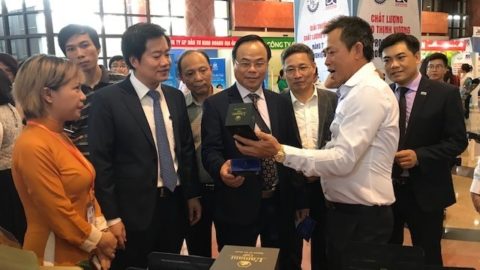
Products of URC Vietnam Co., Ltd. apply quality management standards for export to many countries
By the end of 2019, Vietnam has signed 13 free trade agreements (FTA), 3 FTA are in the process of negotiation. In order to help enterprises expand their markets and increase exports of goods to international markets, improve competitiveness, the national standards system (TCQG) must be in harmony with international and regional.
Help expand exports
The TCQG system currently has about 11,500 standards with a rate of 54% in harmony with the region and internationally, built by 13 ministries of specialized management. In particular, in the current period of deep international integration, standards in harmony with international will help businesses expand exports of goods to international markets.
Mr. Hoang Manh Tan – Deputy General Director of Son Ha Corporation – said that the system of standards and regulations helps enterprises in internal issues such as reducing the proportion of non-standard goods; minimizing the rate of research on new goods; improve coordination with suppliers to customers, help improve the quality and prestige of enterprises. Currently, Son Ha’s products have been exported to many countries in the world, so in addition to complying with Vietnamese standards and standards, the application of standards and standards of countries is very important, helping to minimize many jobs and costs for enterprises.
Meanwhile, Mr. Pham Ngoc Bich – Deputy General Director of Dong Nai Electrical Equipment Corporation (THIBIDI) – said that the purpose of integration is to create favorable conditions for Vietnamese enterprises to enter foreign markets, creating conditions for domestic consumers to use products of different countries. THIBIDI Dong Nai aims to export products abroad so having standards, especially standards in harmony with the world, will help partners from other countries to trust more in THIBIDI’s products. At that time, the company can easily bring products to many countries around the world. Vietnam standards are harmonious, highly compatible with international standards will be a favorite for enterprises in the process of producing and distributing domestic products as well as exporting abroad.
Close the gap
According to Mr. Tran Van Hoc – Vice Chairman of the Vietnam Association of Science and Technology Standards and Quality, standards are tools of manufacturers and business people, but for a long time, often published by state agency’s standards, then enterprises applied. “The standard comes from enterprises, must be proposed by enterprises, set standards, because no one other than enterprises understands how the product needs to be, how to express it” – Mr. Tran Van Hoc Said.
In order to bridge the harmonious ratio gap between Vietnam’s standard system and internationalization, Vietnam needs to socialize and promote as quickly as possible the standardization process, from the annual planning and planning stage to the development to the drafting, publication and release. Therefore, the role of enterprises in the stages is very important, since the planning stage, the plan participates in the process of making standards and final implementation.
On the side of state management agencies, it is necessary to review and improve the legal system, mechanisms and policies related to the national standards system in order to effectively implement the FTA that Vietnam has and will sign; take advantage of opportunities to prevent and mitigate challenges caused by international disputes, especially international trade and investment disputes. At the same time, increased participation in the activities of leading international standards organizations, development of bilateral relationships with other foreign standard organizations.
Good implementation of the objectives will contribute to reducing and moving towards removing unnecessary technical barriers to trade, building technical barriers in line with international commitments that Vietnam has signed.
Productivity and Quality Office